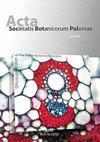Ethnobotanical Study on Garcinia (Clusiaceae) in China
IF 1.1
4区 生物学
Q3 PLANT SCIENCES
引用次数: 5
Abstract
The genus Garcinia L. (Clusiaceae) is gaining increasing scientific attention worldwide owing to its ethnobotanical and pharmacological significance. In China, even though Garcinia plants have long been used for food, ethnomedicine, building materials, and other purposes, a comprehensive ethnobotanical study of the genus is notably limited. In the current study, the ethnobotanical importance of Garcinia plants has been extensively investigated through field surveys and literature reviews. Our studies revealed that Garcinia plants have been used in folk medicine since ancient times in China, including the Northern Song Dynasty, 960–1127 AD. Through their extensive interactions with genus, the Chinese people have gained various traditional knowledge, which is reflected in the following six aspects: food, traditional medicines, ornamental trees, construction and technology, cultural and spiritual significance, and miscellaneous uses. In particular, the four species: Garcinia hanburyi , G. paucinervis , G. xanthochymus , and G. oblongifolia , have cultural or spiritual values, among which G. paucinervis could be considered a cultural keystone species in the local communities, considering its crucial contribution to people’s cultures, spirits, and community identity. However, in general, some concerns originating from swift socio-economic changes have also been identified in the knowledge and Garcinia species. Strategies are needed to conserve traditional botanical knowledge, as well as plants.标题中国藤黄属植物的民族植物学研究
藤黄属(藤黄科)由于其民族植物学和药理学意义,在世界范围内受到越来越多的科学关注。在中国,尽管藤黄植物长期以来一直被用于食品、民族医学、建筑材料和其他目的,但对该属的全面民族植物学研究却非常有限。在目前的研究中,通过实地调查和文献综述,对藤黄植物的民族植物学重要性进行了广泛的调查。我们的研究表明,藤黄植物在中国自古以来就被用于民间医学,包括公元960–1127年的北宋。通过与属的广泛互动,中国人获得了各种传统知识,体现在以下六个方面:食物、传统药物、观赏树木、建筑和技术,文化和精神意义,以及各种用途。特别是,这四个物种:汉紫荆、穷紫荆、黄壶菌和长叶紫荆,具有文化或精神价值,其中穷紫荆可以被视为当地社区的文化基石物种,因为它对人们的文化、精神和社区认同做出了重要贡献。然而,总的来说,在知识和藤黄属物种中也发现了一些源于快速社会经济变化的担忧。需要采取策略来保护传统植物学知识和植物。
本文章由计算机程序翻译,如有差异,请以英文原文为准。
求助全文
约1分钟内获得全文
求助全文
来源期刊
CiteScore
2.00
自引率
10.00%
发文量
18
审稿时长
1 months
期刊介绍:
The journal has been published since 1923 and offers Open Access publication of original research papers, short communications, and reviews in all areas of plant science, including evolution, ecology, genetics, plant structure and development, physiology and biochemistry.

 求助内容:
求助内容: 应助结果提醒方式:
应助结果提醒方式:


